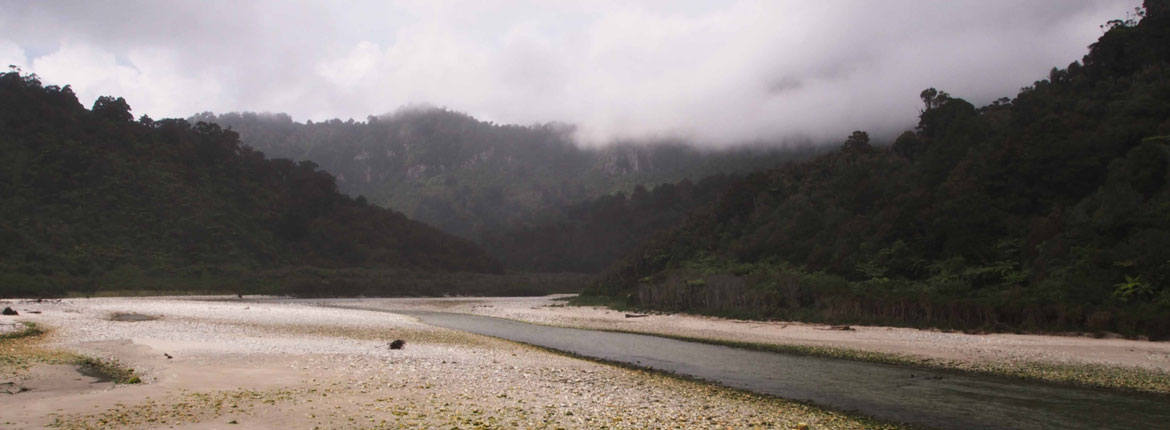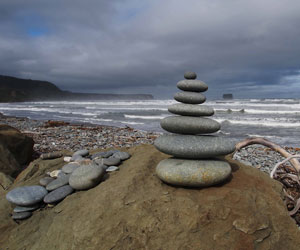
To the Other Side
Chris van Ryn loops over the alps to the West Coast and back.
Cocooned in a capsule of temperate air, I leave Christchurch and head towards the alpine pass which Maori traversed centuries ago in search of pounamu and moa. Today, this landscape is punctuated with small towns that cling to the geography despite harsh wind, snow, catastrophe and mercurial populations.
The Old West Coast Road is ruler straight, bisecting the plains that reach out to the Southern Alps. My journey takes me through Arthur’s Pass – named after the chief surveyor Arthur Dobson. It’s a winding road, with a 16° pitch, and on both sides the mountains are raw and rugged without their winter white.
In one field is a curious sight: a cluster of irregular rocks protruding like turrets. The road sign reads ‘Castle Hill’. Maori called this place Kura Tawhiti – which means ‘treasure from a distant land’. Limestone pushed upwards has been sculpted by water into distinctive curvaceous forms – a mecca for practising climbers.
I stop at the midpoint of the pass for coffee. Sitting outside, I watch a steady stream of trampers trudge by and delight in the antics of a kea on a nearby table, as it rips apart a stolen chocolate bar.

The route takes me down into the Otira Gorge. The roads are a marvel of engineering and human endeavour, with sections literally ‘clipped’ to the stone cliff face. In the terrible winter of 1865 men laboured with pick and shovel to carve a road linking Christchurch with the West Coast goldfields. The sign ‘Death’s Corner’ marks a lookout over a spectacular curving viaduct that spans the gorge. I wonder how many men lost their lives in the making of this road.
The Brunner Mine on the edge of the Brunner River is signalled by a 14-metre brick chimney built in 1904, an imposing sentry to the old mine entrance. This site marks the birth of New Zealand’s coal-powered age and growing prosperity. It is also the scene of tragedies, the worst being the disaster of March 1896, which saw the loss of 65 lives. An omen for the future? The Pike River Mine disaster in November 2010, which killed 29, has wreaked havoc on the prosperity of Greymouth.
I arrive in the early afternoon. All is quiet, with the exception of Mawhera Quay where the Speights Ale House is located. I read the congregation of cars outside as a good sign, and step inside.
The wind dances with the towering pine trees, then swoops down to ruffle the fields of flax.
Mawhera – the menu tells me – is the Maori name for ‘bright running waters’, referring to the periodic flooding of the nearby Grey River. I order a venison pie and walk around the recently restored interior, peering at photos from 1905 of a swamped Quay.
The following morning I head along the coastal road towards Westport, the smell of the sea carried on the wind. The beaches are strewn with pale driftwood and dried seaweed, and rocks of all colours shaped smooth by the waves. It begins to drizzle, the wind dances with the towering pine trees, then swoops down to ruffle the fields of flax.
Halfway between Greymouth and Westport, I discover the Pancake Rocks at Punakaiki. These giant limestone formations have been sculpted by the relentless movement of tide, wind and rain, which has worn away portions of rock, leaving the most exquisite layered forms.
On arrival in Westport, population 6,000, I notice a liveliness not present elsewhere on the coast. Much of its population growth is due to the influx of miners from countries like South Africa, Australia and Fiji and, of course, those who left Greymouth for the safer open cast mining that Westport supports.
Continuing on the highway takes me through Reefton, the first town in the southern hemisphere to have electricity and street lights. To walk down its main street is to traverse 150 years of New Zealand architecture. The buildings are either restored or reconstructed in architecture of the period. There are attractive wooden awnings with hanging baskets, weatherboard façades that reach high above the roofline, wooden floors worn smooth by 100 years of shuffling feet, and counters that run the length of the shop.
I head down State Highway 69, the road in company with the river. Without warning, the road narrows to a single lane. Incredibly, it is simply hacked out of the stone cliff face, dropping sharply to the river on my left. I inch forward, anticipating at any moment an oncoming vehicle.
A long breath escapes me when the road widens and winds its way into the Victoria Forest. Soon, I am driving through dappled light under a magnificent canopy of Mountain beech. The trunks on either side rise tall, a sooty charcoal colour with smudges of silver and orange. Green leaves glow where light has squeezed a passage through the thicket. I pull over.
A short way into the bush the air pricks my skin and damp strikes my nose. I am enveloped by a cacophony of bird chatter. Soaring above all is the distinctive, forthright warble of the tui.
I spend the night at Maruia Springs, an onsen i.e. hot springs with Japanese style bathing. The resort is loaded with therapeutic promise; a restful soak in natural healing sulphur springs, a shiatsu massage, accommodation overlooking the river and mountain, and fine dining (both Japanese and European). It is tucked on the edge of a river, with its back to the Lake Sumner Forest Park.
For more than a century Maruia has attracted visitors to its springs. Maori hunting parties likely bathed their feet in the soothing waters. I’m told that soaking in a hot spa for 40 minutes will lose me 300 calories.
I’m willing to try it. The river is gurgling over rocks and tui are yodelling, as I slip into 45° waters and watch the glow of a golden sun slip behind the hills.
Nine kilometres off the state highway is Hanmer Springs, a township at the foot of Mt Isobel. The streets are immaculately maintained, gardens and lawns finely manicured and a central boulevard is edged with 100-year-old Canadian redwoods. With a permanent population of around 700, transients flock to the town all year round to take advantage of the hot pools. The price of property is on a par with Auckland, a testament to the township’s popularity.
Leaving the mountainous terrain, the bustle of city life creeps in: cars increase in number, trucks roar past and petrol stations become more frequent. I turn off at the Hurunui Hotel and stop for a break. The barman tells me this place has the oldest liquor licence in New Zealand – 150 years old. The original owner, John Hastie, was granted a licence in 1860 on the condition that he provided: eight beds in four rooms, shelter for six horses, stockyards for yoking up cattle, horses for travellers fording the river, and directions for travellers to a safe fording place. It seems a fitting place to sign off my road trip.
Reported by Chris van Ryn
